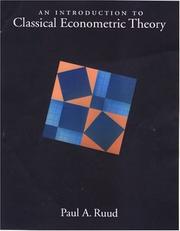| Listing 1 - 5 of 5 |
Sort by
|

ISBN: 0195111648 9780195111644 Year: 2000 Publisher: New York (N.Y.) : Oxford university press,
Abstract | Keywords | Export | Availability | Bookmark
 Loading...
Loading...Choose an application
- Reference Manager
- EndNote
- RefWorks (Direct export to RefWorks)
Mathematical statistics --- Quantitative methods (economics) --- Econometrics --- Econométrie --- 330.115 --- 330.015195 --- Economics, Mathematical --- Statistics --- Econometrie --- Econometrics. --- 330.115 Econometrie --- Econométrie
Digital
Year: 2016 Publisher: Cambridge, Mass. National Bureau of Economic Research
Abstract | Keywords | Export | Availability | Bookmark
 Loading...
Loading...Choose an application
- Reference Manager
- EndNote
- RefWorks (Direct export to RefWorks)
The U.S. Environmental Protection Agency (USEPA) maintains networks of pollution monitors for two basic purposes: to check and enforce the attainment of national ambient air quality standards (NAAQS) and to provide useful data for studying pollution and its effects. These purposes imply conflicting criteria for the locations of a limited number of monitors. To check the attainment of standards, monitors are placed where pollution levels are highest. Monitors are not required where standards have always been met and there are no new pollution sources. To provide useful data for studying pollution and its effects, monitors are placed to observe outcomes under a variety of pollution levels. This study asks the following questions. What factors affect when a monitor is retired from the network? What drives the decision to add a new site? What causes year-to-year changes in the number of monitors? We tackle these questions with a particular focus on the role of regulatory compliance and pollution levels in the context of monitors for tropospheric ozone (O3). Using a panel dataset of monitors in the contiguous US spanning the years 1993 to 2011, we find that peak O3 readings in the prior period are significantly associated with the regulator's decision of whether to add or to drop a monitor in the following period. While compliance with the NAAQS for O3 is not consistently associated with network composition, compliance with the PM2.5 NAAQS does appear to affect changes to the network.
Book
Year: 1993 Publisher: Amsterdam: North-Holland,
Abstract | Keywords | Export | Availability | Bookmark
 Loading...
Loading...Choose an application
- Reference Manager
- EndNote
- RefWorks (Direct export to RefWorks)
Book
Year: 1984 Publisher: Cambridge, Mass. National Bureau of Economic Research
Abstract | Keywords | Export | Availability | Bookmark
 Loading...
Loading...Choose an application
- Reference Manager
- EndNote
- RefWorks (Direct export to RefWorks)
Over the period 1960 - 1983 the proportion of federal tax revenue raised by taxation of labor supply has risen from 57-77 percent. In this paper, we specify and estimate a model of family labor supply which treats both federal and state taxation. Husbands and wives labor supply are treated jointly rather than in aseparate manner as in previous research. A method to calculate the virtual wage for nonworking spouses is used within a utility maximizing framework to treat correctly the joint family labor supply decision. Joint family efforts are found to be important. The efficiency cost (deadweight loss) of labor taxation is estimated to be 29.6% of tax revenue raised. The effect of the new 10% deduction to ease the marriage tax for working spouses leads to a prediction of 3.8% increase in wives labor supply and a .9% decrease in husbands labor supply.Overall taxes paid are predicted to decrease by 3.4%.
Book
Year: 2016 Publisher: Cambridge, Mass. National Bureau of Economic Research
Abstract | Keywords | Export | Availability | Bookmark
 Loading...
Loading...Choose an application
- Reference Manager
- EndNote
- RefWorks (Direct export to RefWorks)
The U.S. Environmental Protection Agency (USEPA) maintains networks of pollution monitors for two basic purposes: to check and enforce the attainment of national ambient air quality standards (NAAQS) and to provide useful data for studying pollution and its effects. These purposes imply conflicting criteria for the locations of a limited number of monitors. To check the attainment of standards, monitors are placed where pollution levels are highest. Monitors are not required where standards have always been met and there are no new pollution sources. To provide useful data for studying pollution and its effects, monitors are placed to observe outcomes under a variety of pollution levels. This study asks the following questions. What factors affect when a monitor is retired from the network? What drives the decision to add a new site? What causes year-to-year changes in the number of monitors? We tackle these questions with a particular focus on the role of regulatory compliance and pollution levels in the context of monitors for tropospheric ozone (O3). Using a panel dataset of monitors in the contiguous US spanning the years 1993 to 2011, we find that peak O3 readings in the prior period are significantly associated with the regulator's decision of whether to add or to drop a monitor in the following period. While compliance with the NAAQS for O3 is not consistently associated with network composition, compliance with the PM2.5 NAAQS does appear to affect changes to the network.
| Listing 1 - 5 of 5 |
Sort by
|

 Search
Search Feedback
Feedback About UniCat
About UniCat  Help
Help News
News